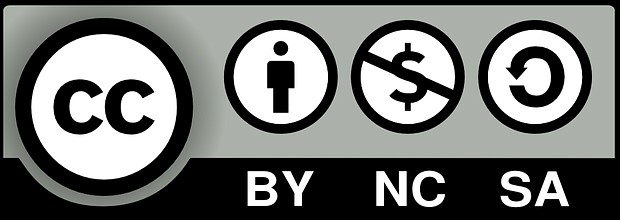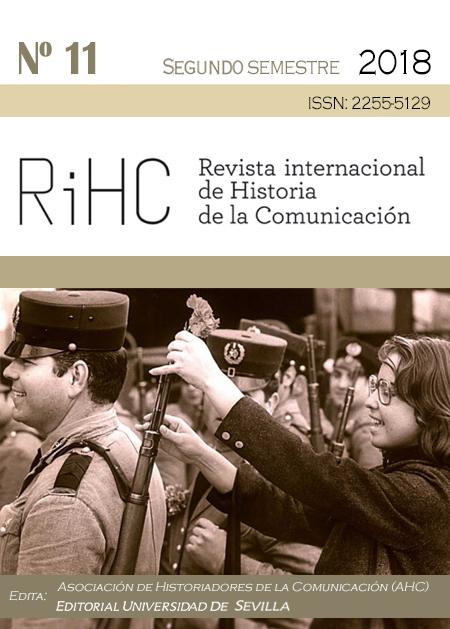Prosopografía y career research en la historia del periodismo (y una propuesta de aplicación)
DOI:
https://doi.org/10.12795/RiHC.2018.i11.06Palavras-chave:
Historiografía, Prosopografía, Entrevistas semiestructuradas, Análisis de redes sociales, Etnografía de las redacciones.Resumo
Esta es una propuesta de tipo metodológico. Se propone la aplicación de una técnia bien conocida en la historiografía contemporánea para grupos sociales y profesionales, la prosopografía o biografía colectiva, en este caso desplazando el tradicional centro de atención dispensados a las organizaciones de medios de comunicación como objeto principal de estudio hacia la historia social de las personas que participan en dichas estructuras, y principalmente a los periodistas. Proponemos complementar la aplicación de la prosopografía, y el diseño, empleo y explotación de bases de datos ad hoc, con otras metodologías propias de las ciencias sociales, como las entrevistas semiestructuradas, y focalizadas en función de las categorías y campos empleados en la prosopografía, e incluso el análisis de redes sociales, con objeto de sentar las bases de una investigación sobre carreras profesionales. Se plantea la aplicación de estas técnicas al estudio de la historia de los medios digitales.
Downloads
Referências
ASENSIO, E.; CALVO, L.; DOMINGO, D. yRUBIES, T. (2003): Informe sobre la situació laboral i professional del periodista digital a Catalunya, Barcelona, Grup de Periodistes Digitals.
BELLOTTI, E. (2015): Qualitative Networks. Mixed methods in sociological research, New York, Routledge.
BERGER, A. A. (2000): Media and Communication Research Methods: An Introduction to Qualitative and Quantitative Approaches. London; Thousand Oaks, SAGE.
BIARDZKA, E. (2012): “Les didascalies de l’énonciateur cité dans le journal Le Monde” en Studii de lingvistică 2, pp. 25 - 44.
BROERSMA, M. (2011): “From press history to the history of journalism” en M&z, 3, pp. 17-28.
BRÜGGER, N. (2010): Web History, New York, Peter Lang.
BRÜGGER, N. (2012): “Web historiography and Internet Studies: Challenges and perspectives” en New Media & Society,15(5), pp. 752–764.
BRÜGGER, N. y KOLSTRUP, S. (2002): Media history, Theories, methods, analysis, Aarhus, Aarhus University Press.
BUNOUT, E. (2016): “Visualisation of the prosopography of Polish and German experts on Eastern Europe: Are non-computed data useable for visualisation?” en DH Benelux conference 2016. Disponible en Internet (12-09-2018): http://www.dhbenelux.org/wpcontent/ uploads/2016/05/63BunoutEstelleFinalAbstractDHBenelux2016long.pdf.
CALVO BERMEJO, L. (2005): “El Informe sobre la Situación Laboral y Profesional del Periodista Digital en Cataluña”, en Mediatika, 11, pp. 171-183.
COHEN, N. S. (2015): “From Pink Slips to Pink Slime: Transforming Media Labor in a Digital Age” en The Communication Review, 18, pp. 98–122.
COHEN, L. y MALLON, M. (2001): “My brilliant career? Using stories as a methodological tool in careers research”, en. International Studies of Management & Organization, 31(3), pp. 48-68.
COOK, J. W. (2012): “The kids are all right: On the "turning" of cultural history”. en American Historical Review, 117(3), pp. 746-771.
CORELL DOMENECH, M. V. (2013): Científicos, vulgarizadores y periodistas: estudio y análisis de la divulgación de la ciencia en La Ilustración Española y Americana (1869-1898), Tesis doctoral, Valencia, Universidad de Valencia.
CRESWELL, J. W. (2009): Research Design: Qualitative, Quantitative, and Mixed Method Approaches, SAGE, London; Thousand Oaks.
CRUZ, A. de la y LÓPEZ-CORDÓN, M. V. (2016): “Impresores que escriben, periodistas que editan en tiempos de crisis y revolución (España 1780-1823)” en El Argonauta Español, 13.
CUXAC, M. (2015): Journaux et journalistes au temps du fascisme. Turin, 1929-1940, Tesis doctoral, Lyon; Torino, Université Lumière Lyon 2; Università degli studi di Torino.
DAVIDSON, R. y MEYERS, O. (2016): “Toward a Typology of Journalism Careers: Conceptualizing Israeli Journalists’ Occupational Trajectories” en Communication, Culture & Critique, 9, pp. 193–211.
DENZIN, N.K. y LINCOLN, Y.S. (2007): The Handbook of Qualitative Research, Thousand Oaks, CA, SAGE.
DÍAZ NOCI, J. (2018, en prensa): “Naixement i consolidació del periodisme a Internet: el cas dels mitjans públics Diari de Barcelona i La Malla en Barcelona. Quaderns d’Història, 24.
DÍAZ NOCI, Javier (2013): “A history of journalism on the Internet: A state of the art and some methodological trends” en Revista internacional de Historia de la Comunicación, 1(1), pp. 253-272.
DICKINSON, R.; MATTHEWS, J. y SALTZINS, K. (2013): “Studying journalists in changing times: Understanding news work as socially situated practiced” en The International Communication Gazette, 75(1), pp. 3-18.
FETTERMAN, D. M. (2010): Ethnography: Step-by-Step. Los Angeles, SAGE.
FLICK, U. (2011): Introducing Research Methodology: A Beginner's Guide to Doing a Research Project. London, SAGE.
FONTENELLE E SILVA, M. y GASTAL GRILL, I. (2014): “Atuaçao política e produçao escrita de jornalistas no parlamento brasileiro”, en Cad. Pes., São Luís, v. 21, n. especial.
FRIEDMAN, S. (2017): “‘Like Skydiving without a Parachute’: How Class Origin Shapes Occupational Trajectories in British Acting”, en Sociology 51(5), pp. 992–1010.
HOWARTH, K. (1999): Oral history, Gloucestershire, Sutton.
KEATS-ROHAN, K. S. B. (ed.): Prosopography Approaches and Applications: A Handbook, Oxford, University of Oxford Linacre College Unit for Prosopographical Research.
KING, N. y HORROCKS, C. (2010): Interviews in Qualitative Research. Thousand Oaks, CA: SAGE Publications.
KVALE, S. y BRINKMANN, S. (2009): Interviews: learning the craft of qualitative research interviewing, Los Angeles, Sage.
LÓPEZ GARCÍA, X. y PEREIRA FARIÑA, X. (2010): Convergencia digital. Reconfiguración de los medios de comunicación en España, Santiago de Compostela, Universidade de Santiago de Compostela.
MEYEN, M. y FIEDLER, A. (2013): “Journalists in the German Democratic Republic (GDR): A collective biography” en Journalism Studies, 14(3), pp. 321-335.
MEYEN, M. y WIEDEMANN, T. (2017): “Journalism Professors in the German Democratic Republic: A Collective Biography” en International Journal of Communication 11(2017), pp. 1839–1856.
MEYERS, O. y DAVIDSON, R. (2015): “Toward a Typology of Journalism Careers: Conceptualizing Israeli Journalists’ Occupational Trajectories” en Communication, Culture & Critique 9, pp. 193–211.
MEYERS, O. y DAVIDSON, R. (2017): “Interviewing interviewers: Collecting, analyzing and generalizing from occupational life histories of journalists” en The Communication Review, 20(4), pp. 277-295.
NAGY HESSE-BIBER, S. (2010): Mixed Methods Research: Merging Theory with Practice, New York, Guilford Press.
NAGY HESSE-BIBER, S. (2011): The Handbook of Emergent Technologies in Social Research, New York; Oxford, Oxford University Press.
OLDFIELD, S. J. (2015): “Narrative Methods in Sport History Research: Biography, Collective Biography, and Prosopography” en International Journal of the History of Sport, 32(15) pp. 1855-188.
OLDFIELD, S. J. y DAY, D. (2011): Narrative, Biography and Prosopography: Historical Method and its Implications. MMU Institute for Performance Research, Sports Coaching: Pasts and Futures Conference, Saturday 25 – Sunday 26 June at Wychwood Park, Cheshire.
ONANDIA MARTÍNEZ, A. (2017): De la biografía a la prosopografía: Los parlamentarios de la Comunidad Autónoma Vasca (1977-1982), Tesis doctoral. Bilbao. Universidad del País Vasco.
PONT-SORRIBES, C.; LUIS, R..; SANMARTÍ, José M. (2017): “Aproximación etnográfica del periodista de la Transición como fuente histórica: Estudio de la relación con los actores políticos y de los cambios en la producción de los medios escritos” en Historia y Comunicación Social, 22(1), pp. 141-156.
POOLEY, J. D. y PARK, D. W. (2013): “Communication research”. En Simonson, P. et al., The handbook of communication history, London, Routledge, pp. 76-90.
POPKIN, J. D. (1990): “The Press and the French Revolution after Two Hundred Years” en French Historical Studies, 16(3), pp. 664-683.
RANDLE, K. et al. (2015): “Towards a Bourdieusian analysis of the social composition of the UK film and television workforce” en Work, employment and society, 29(4), pp. 590–606.
RAYMOND, J. (1999): “The History of Newspapers and the History of Journalism: Two Disciplines or One?” en Media History , 5(2), pp. 223–232.
ROSENBERG, L. (2017): “Etnografía del trabajo periodístico. Apuntes sobre la inserción del investigador en la sala de redacción de un diario argentino” en Comunicación y sociedad, 28, pp. 87-109.
SAVILLE-TROIKE, M. (1989): The Ethnography of Communication: An Introduction, Oxford, Basil Blackwell.
SCOTT, Ben (2005): “A contemporary history of digital journalism” en Television & New Media, 6(1), pp. 89-126.
SILVERMAN, D. (2011): Qualitative Research: Issues of Theory, Method and Practice, London, SAGE.
SIMONSON, P. y PARK, D. W. (2015): The international history of communication study, London, Routledge.
SORIANO CLEMENTE, J. (2017): “Investigar la comunicación con métodos biográficos. Propuestas de estudio” en Historia y Comunicación Social, 22(1), pp. 157-171.
TAMELING, K. y BROERSMA, M. (2013): “De-converging the newsroom: Strategies for newsroom change and their influence on journalism practice” en The International Communication Gazette,75(1), pp. 19-34.
TRACY, K. y ROBLES, J. S. (2010): “Challenges of Interviewers’ Institutional Positionings: Taking Account of Interview Content and the Interaction” en Communication Methods and Measures, 4(3), pp. 177–200.
TSUI, C. Y. S. y LEE, F. L. F. (2012): “Trajectories of women's journalists careers in Hong Kong. A field theory perspective” en Journalism Studies, 13(3), pp. 370-385.
URQUIJO, M. (2014): “Renovación metodológica de los diccionarios biográficos nacionales”, en Agirreazkuenaga, J. y Alonso, E. J. (eds.), Naciones en el Estado-nación: La formación cultural y política de naciones en la Europa contemporánea. Barcelona, Base, pp. 57-63.
USHER, N. (2015): “Newsroom moves and the newspaper crisis evaluated: Space, place, and cultural meaning” en Media, Culture & Society, 37(7), pp. 1005-1021.
WELLER, T. (ed.) (2013): History in the Digital Age, London; New York, Routledge.
WILLIG, I. (2012): “Newsroom ethnography in a field perspective” en Journalism, 14(3), pp. 372-387.
Downloads
Publicado
Como Citar
Edição
Secção
Licença
RiHC. Revista internacional de Historia de la Comunicación es una publicación de acceso libre, ofrece su contenido bajo el principio de que hacer disponible gratuitamente la investigación al publico apoya a un mayor intercambio de conocimiento global.
RIHC. Revista internacional de Historia de la Comunicación se adhiere a las diferentes iniciativas que promueven el acceso libre al conocimiento, por lo que todos los contenidos son de acceso libre y gratuito y se publican bajo licencia de Creative Commons Reconocimiento-NoComercial 4.0 Internacional.

En virtud de ello, los autores que publiquen en esta revista aceptan las siguientes condiciones:
Los autores conservan los derechos de autor y ceden a la revista el derecho de la primera publicación, con el trabajo registrado con la licencia de atribución de Creative Commons, que permite a terceros utilizar lo publicado siempre que mencionen la autoría del trabajo y a la primera publicación en esta revista.
Los autores pueden realizar otros acuerdos contractuales independientes y adicionales para la distribución no exclusiva de la versión del artículo publicado en esta revista (p. ej., incluirlo en un repositorio institucional o publicarlo en un libro) siempre que indiquen claramente que el trabajo se publicó por primera vez en esta revista.
Se permite y recomienda a los autores publicar su trabajo en Internet (por ejemplo en páginas institucionales o personales) ya que puede conducir a intercambios productivos y a una mayor y más rápida difusión del trabajo publicado (vea The Effect of Open Access).
No prevé moving wall o período de embargo
Debe utilizarse la versión de editor/PDF
La fuente editorial debe reconocerse













